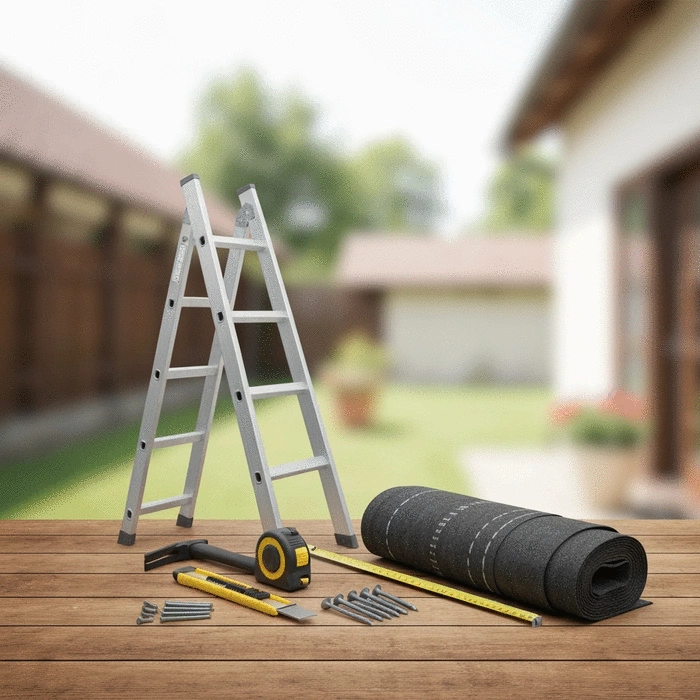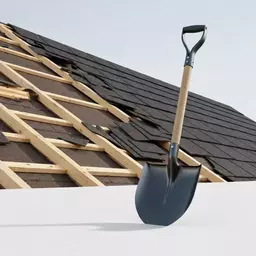Choosing Roofing Tools for DIY Repair

Posted on: 2025-10-06
By: Jordan M. Knox
As you gear up to tackle that roof repair, consider this: a well-planned DIY project can save you both time and money while empowering you with practical skills. Ready to dive in? Here’s what you’ll gain from understanding DIY roof repair.
What You Will Learn
- DIY roof repair involves assessing damage, making fixes, and ensuring your roof's integrity.
- Preparation is key: inspect your roof for damage and gather necessary tools before starting.
- Recognize common roof issues, including shingle curling, flashing rust, and sheathing rot, to address them effectively.
- Investing in a solid toolkit can enhance the quality and efficiency of your roof repairs.
- Engaging with a community can provide support, tips, and shared experiences, making your journey less daunting.
- Utilize online resources to stay informed and improve your DIY roofing skills continuously.
DIY Roof Repair Journey
This visual outlines the essential steps and tools involved in a successful DIY roof repair project.
Assessing Damage & Needs
- ✓ Inspect for missing shingles, leaks, rot
- ✓ Identify shingle, flashing, sheathing issues
- ✓ Determine required tools & materials
Essential Tool Kit
- ⚙ Basic: Hammer, utility knife, roofing nails
- ⚙ Specialized: Roofing nail gun, pry bar
- ⚙ Safety: Goggles, gloves, sturdy harness
Learning & Guidance
- 📚 Continually seek knowledge
- 📚 Engage with experts & workshops
- 📚 Utilize resources like Roofing Explained
Community & Support
- 👤 Join DIY forums & groups
- 👤 Share projects & ask questions
- 👤 Leverage online roofing resources
Understanding Your DIY Roof Repair Needs
When it comes to tackling roof repairs on your own, it’s essential to understand what you’re getting into. DIY roof repair can be a rewarding experience, but it also requires careful planning and the right tools. Have you thought about what repairs you might need? Knowing the basics will set you up for success!
First off, let's define what DIY roof repair really means. This often involves assessing damage, making necessary fixes, and ensuring your roof remains intact. It's not just about patching up shingles; you might need to delve into flashing or even sheathing repairs. Understanding these aspects can help you anticipate what tools and materials you'll need. For a comprehensive guide on keeping your roof in top condition, check out our roof maintenance and inspection guide.

Defining DIY Roof Repair: What to Expect
Embarking on a DIY roof repair project means you should be prepared for a variety of tasks. Typically, you’ll find yourself inspecting, cleaning, and repairing different parts of your roof. Don't worry if it sounds overwhelming! Start with small repairs and work your way up as your confidence grows.
- Inspect your roof for visible signs of damage.
- Gather your materials and tools before starting.
- Follow safety protocols to ensure a secure working environment.
Getting familiar with what’s involved will make the process smoother and help you avoid common pitfalls.
Assessing Roof Damage: How to Identify What Tools You Need
Before you dive into repairs, it’s crucial to assess the damage. Look for missing shingles, leaks, or any signs of rot. Once you identify the issues, you can determine what tools you'll need for the job. Remember, the right tools can make all the difference!
- Binoculars for inspecting hard-to-see areas.
- A ladder that reaches your roof safely.
- Protective gear, like gloves and a helmet.
By organizing your tools ahead of time, you’ll be more prepared to tackle each task effectively.
Common Types of Roof Damage: Recognizing Shingle, Flashing, and Sheathing Issues
Understanding the types of damage you might encounter is key to effective repairs. Shingles can curl, crack, or go missing altogether. Flashing, which protects joints in your roof, can also become damaged, leading to leaks. Lastly, sheathing can rot and deteriorate if moisture gets trapped.
- Shingle issues: Look for curling or missing pieces.
- Flashing problems: Check for rust or gaps.
- Sheathing deterioration: Inspect for soft spots or decay.
By recognizing these common problems, you’ll be better equipped to address them during your DIY repair projects.
Essential Roofing Tools for DIY Repairs
Now that you understand your repair needs, let's talk tools! Having the right equipment on hand is crucial for any roofing project. Whether you're a seasoned DIYer or just starting out, a solid toolkit can save you time and frustration. For more information on different roofing materials and their characteristics, explore our guide on roofing materials pros and cons.
- Basic tools to get started: hammer, utility knife, and roofing nails.
- Specialized tools for specific tasks: roofing nail gun and pry bar.
- Safety gear: goggles, gloves, and a sturdy harness.
With the right tools and safety measures, you'll be ready to take on those roofing repairs with confidence!
Pro Tip
Did you know? One of the best ways to ensure the longevity of your roofing repairs is to regularly inspect your roof after severe weather events. This proactive approach allows you to catch any issues early, preventing minor problems from escalating into costly repairs. Make it a habit to check your roof every few months!
Summarizing Your DIY Roofing Tool Selection Journey
As we wrap up our exploration of DIY roofing tools, it’s essential to reflect on the key aspects that make your tool selection journey successful. Choosing the right tools not only improves the quality of your repairs but also enhances your overall experience. Remember, having a well-rounded toolkit tailored to your specific project needs is vital for confident DIY roofing!
Here are some key takeaways to consider when selecting your tools:
- Identify the types of repairs you’ll perform and the roof materials you’ll be working with.
- Ensure you invest in essential tools that enhance safety and efficiency.
- Don’t underestimate the importance of quality; reliable tools make for a smoother repair process.
- Be open to learning about new tools that may aid in your roofing projects.
By keeping these points in mind, you’ll be better equipped to tackle your roofing repairs with confidence and precision. I often remind homeowners that it’s not just about having the tools but knowing how to use them effectively!
Encouraging Further Learning and Professional Guidance
Venturing into DIY roofing can be both exciting and daunting. I encourage you to continually seek knowledge and professional guidance as you embark on your projects. Engaging with seasoned experts can help you navigate complex situations and refine your skills. Consider attending local workshops or online webinars that focus on roofing repairs.
Don't hesitate to reach out to Roofing Explained for insightful resources. We provide comprehensive guides that cover everything from tool usage to advanced roofing techniques. Staying informed helps you make better decisions, and I’m here to support your learning journey!

Engaging with the Community for Ongoing Support
Join DIY Forums and Groups for Shared Experiences
Connecting with others who share your interest in DIY roofing can be incredibly beneficial. Joining forums or social media groups allows you to exchange experiences, tips, and advice with fellow enthusiasts. These communities can provide answers to questions you may have and encourage you to share your projects!
Popular platforms include:
- Facebook groups focused on home improvement and roofing
- Reddit communities that share DIY tips and tricks
- Local DIY workshops and meetups that foster hands-on learning
By engaging with a community, you not only gain valuable insights but also build connections with individuals who share your passion for roofing!
Share Your Projects and Ask Questions for Expert Advice
Have you completed a DIY roofing project? Sharing your successes and challenges with the community can be a great way to receive feedback and encouragement. Don’t hesitate to ask questions if you encounter difficulties along the way. Most experienced DIYers are more than willing to offer their insights!
By sharing your journey, you contribute to the collective knowledge within the community, helping others who might face similar challenges. Remember, we all learn from each other, and your experiences can inspire new DIYers to take on their roofing projects!
Utilizing Online Roofing Resources for Continued Education
In addition to community engagement, leveraging online resources is vital for ongoing education. Websites like Roofing Explained offer a wealth of information, including articles, videos, and tool reviews that keep you updated on the latest in roofing technology and best practices. To help maintain your roof throughout the year, be sure to check out our seasonal roof maintenance guide for homeowners.
Here are some valuable resources to explore:
- Roofing Explained: Comprehensive guides on repairs, tools, and materials.
- YouTube tutorials: Visual demonstrations of roofing techniques and tool usage.
- Industry blogs: Insights into trends and innovations in the roofing world.
Utilizing these resources will empower you to stay informed and improve your skills, ensuring that you approach each roofing project with confidence and knowledge!
Recap of Key Points
Here is a quick recap of the important points discussed in the article:
- Understand the scope of DIY roof repair, including assessing damage and repairing shingles, flashing, and sheathing.
- Prepare for your project by inspecting your roof for visible damage and gathering necessary tools like ladders and protective gear.
- Recognize common types of roof damage, including curling shingles, rusted flashing, and soft spots in sheathing.
- Invest in essential roofing tools such as hammers, utility knives, and safety gear to enhance efficiency and safety.
- Engage with community forums and online resources to share experiences and gain further insights into DIY roofing projects.
Frequently Asked Questions About DIY Roof Repair
What does DIY roof repair typically involve?
DIY roof repair generally involves assessing roof damage, performing necessary fixes like replacing shingles or repairing flashing, and ensuring the overall integrity of your roof. It focuses on addressing common issues like leaks, missing shingles, and minor structural wear.
What are the most common types of roof damage homeowners might encounter?
Homeowners frequently encounter issues such as curling, cracking, or missing shingles; damaged or rusted flashing which can lead to leaks; and deteriorated sheathing caused by moisture. Identifying these problems early is crucial for effective repair.
What essential tools are needed for basic DIY roof repairs?
For basic DIY roof repairs, you'll need tools such as a hammer, utility knife, and roofing nails. For more specialized tasks, a roofing nail gun and a pry bar can be very useful. Safety gear, including goggles, gloves, and a sturdy harness, is also essential.
How can I learn more about DIY roofing techniques and best practices?
You can continuously learn through various resources, including online platforms like Roofing Explained, YouTube tutorials for visual demonstrations, and industry blogs that offer insights into new technologies and best practices. Engaging with DIY forums and local workshops also provides valuable knowledge and support.
Is it important to join DIY communities for roof repair projects?
Yes, joining DIY forums and groups is highly beneficial. These communities allow you to share experiences, gain tips and advice from fellow enthusiasts, and receive feedback on your projects. They also provide a support network for troubleshooting and continuous learning.
 Ever faced the daunting task of removing old roof shingles? The right tool can transform this labor-
Ever faced the daunting task of removing old roof shingles? The right tool can transform this labor-
 Have you ever stopped to think about how your local weather might be silently dictating the lifespan
Have you ever stopped to think about how your local weather might be silently dictating the lifespan
 Have you considered how your roof can affect your home's comfort and energy efficiency? Understandin
Have you considered how your roof can affect your home's comfort and energy efficiency? Understandin
